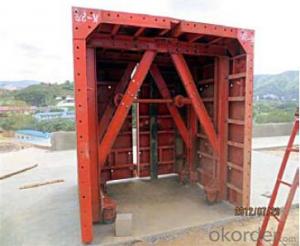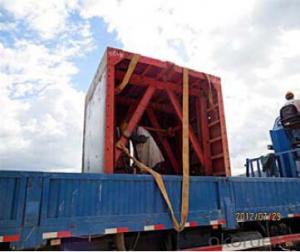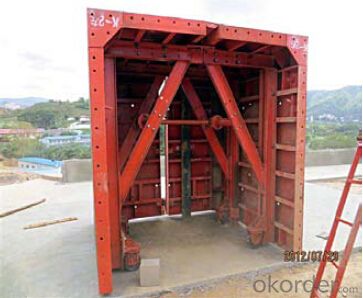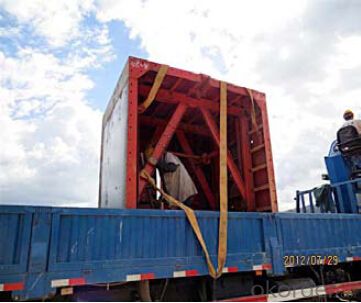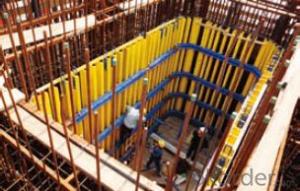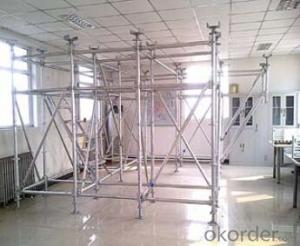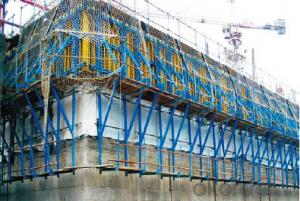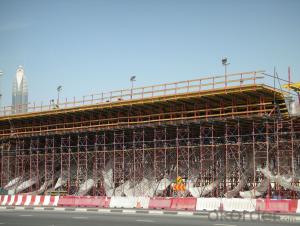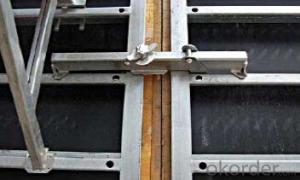Steel Tunnel for Formwork and Scaffolding systems
- Loading Port:
- Tianjin
- Payment Terms:
- TT OR LC
- Min Order Qty:
- 50 m²
- Supply Capability:
- 1000 m²/month
OKorder Service Pledge
Quality Product, Order Online Tracking, Timely Delivery
OKorder Financial Service
Credit Rating, Credit Services, Credit Purchasing
You Might Also Like
Building Tunnel Formwork:
A compositional steel formwork system mainly used in the building which has regular structure
without beams, the excellent formwork system can make the integral pouring for the wall & slab
easily achieved.
Characteristics:
◆ High stiffness, make perfect shape for concrete.
◆ Easy operation, save labor and force.
◆ Fast forming, repeatedly turnover.
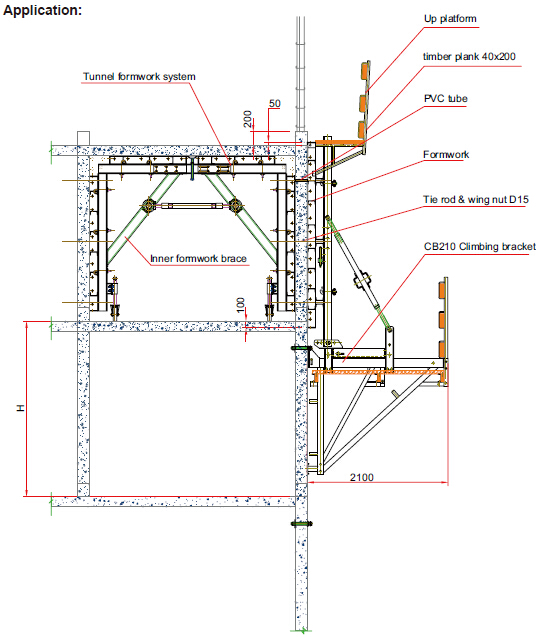
- Q: Can steel formwork be used for office building construction projects?
- Yes, steel formwork can be used for office building construction projects. Steel formwork is a versatile and durable option for concrete construction that offers many advantages. It provides a high level of strength and stability, allowing it to withstand the pressures and loads encountered during the construction process. Steel formwork is also reusable, which makes it a cost-effective choice for large-scale projects like office buildings. Additionally, steel formwork allows for quick and efficient construction, as it can be easily assembled and disassembled, enabling faster turnaround times. Overall, steel formwork is a suitable option for office building construction projects due to its strength, durability, cost-effectiveness, and efficiency.
- Q: What are the common design considerations for steel formwork in bridge construction?
- When it comes to steel formwork in bridge construction, there are several common design considerations that need to be taken into account. These considerations include: 1. Strength and Stability: Steel formwork needs to be designed to withstand the loads it will be subjected to during construction, such as the weight of wet concrete and any construction equipment that may be used. The formwork should be designed to provide adequate strength and stability to ensure the safety of workers and the integrity of the structure. 2. Durability and Reusability: Steel formwork should be designed to be durable and reusable. It should be able to withstand multiple uses without significant deterioration, which can help reduce costs and minimize waste. 3. Flexibility and Adaptability: The design of steel formwork should allow for flexibility and adaptability to accommodate various bridge geometries and dimensions. This is particularly important in bridge construction, as each bridge may have unique design requirements. 4. Ease of Assembly and Disassembly: The formwork should be designed to be easily assembled and disassembled, as this can help expedite the construction process and reduce labor costs. Quick and efficient assembly and disassembly can also minimize disruptions to traffic flow during construction. 5. Safety: Safety is a crucial consideration in any construction project, and steel formwork is no exception. The design should incorporate safety features to protect workers during assembly, disassembly, and concrete pouring. This may include features such as guardrails, access platforms, and fall protection systems. 6. Cost-effectiveness: The design of steel formwork should aim to be cost-effective. This entails considering factors such as material selection, fabrication methods, and ease of transport and installation. The goal is to optimize the overall cost of the formwork while maintaining its functionality and performance. In summary, the design considerations for steel formwork in bridge construction revolve around strength, stability, durability, reusability, flexibility, adaptability, ease of assembly and disassembly, safety, and cost-effectiveness. By carefully addressing these considerations, engineers can ensure the successful and efficient construction of bridges using steel formwork.
- Q: How does steel formwork contribute to better concrete compaction?
- There are several ways in which steel formwork contributes to improved concrete compaction. Firstly, it offers a rigid structure that securely holds the concrete in place while it is being poured and cured. This rigidity prevents any movement or shifting of the concrete, enabling a more even distribution of the concrete mix and reducing the likelihood of segregation or honeycombing. Furthermore, steel formwork often incorporates various features like tie rods and walers, which allow for proper alignment and tightening of the formwork. This ensures that the formwork remains stable and tight, minimizing any gaps or voids that could result in inadequate compaction. In addition, steel formwork is typically designed with smooth surfaces, which facilitates the creation of a smooth and uniform finish on the concrete. This smoothness enhances compaction as the concrete can flow more easily and evenly into all parts of the formwork. Moreover, steel formwork is highly durable and capable of withstanding the pressure exerted by the concrete during the pouring and compaction process. This durability ensures that the formwork remains intact and does not deform or collapse, enabling proper compaction of the concrete. Overall, steel formwork provides a strong and stable structure that allows for enhanced control of the concrete pouring and compaction process. It helps eliminate any potential complications that may arise during compaction, resulting in a concrete structure of higher quality and greater density.
- Q: Can steel formwork be used in retail or commercial construction projects?
- Yes, steel formwork can be used in retail or commercial construction projects. Steel formwork is a versatile and durable solution for creating concrete structures in construction projects. It offers several advantages such as high reusability, excellent dimensional stability, and the ability to handle high concrete pressures. In retail or commercial construction projects, steel formwork can be used for various applications such as constructing columns, walls, beams, slabs, and staircases. It provides a sturdy framework that ensures accurate and smooth concrete placement, resulting in high-quality finishes. Additionally, steel formwork can be easily customized and adjusted to suit different project requirements, making it suitable for projects with complex architectural designs. Furthermore, steel formwork offers significant time and cost savings in construction projects. Its reusability reduces the need for frequent formwork replacements, resulting in reduced material and labor costs. The use of steel formwork also enhances construction efficiency, as it allows for faster assembly, disassembly, and repositioning of formwork components. Overall, steel formwork is a reliable and efficient choice for retail or commercial construction projects, providing the necessary strength and flexibility required for such applications.
- Q: What are the different types of formwork connectors used in steel formwork?
- There are several types of formwork connectors that are commonly used in steel formwork systems. These connectors play a crucial role in ensuring the stability and strength of the formwork structure. Some of the different types of formwork connectors used in steel formwork include: 1. Wedge Lock Connector: This type of connector is widely used in steel formwork systems. It consists of two separate pieces – a wedge and a lock. The wedge is inserted into the formwork joint, and the lock is then inserted to secure the wedge in place. This connector provides a tight and secure connection, which helps in maintaining the formwork's stability. 2. Pin and Wedge Connector: This connector comprises a pin and a wedge. The pin is inserted through the holes in the formwork panels, and the wedge is then driven into the hole, securing the pin in place. The pin and wedge connector is easy to install and provides a strong connection between the formwork panels. 3. Rapid Clamp Connector: This type of connector is designed to quickly and securely connect steel formwork panels. It consists of a clamp that is tightened around the formwork panel, providing a reliable and sturdy connection. The rapid clamp connector is often used in applications where a quick assembly and disassembly of formwork is required. 4. Hook and Loop Connector: This connector utilizes a hook and loop fastening system to connect the formwork panels. The hook and loop strips are attached to the edges of the formwork panels, allowing them to be easily and firmly connected. This type of connector is commonly used in applications where frequent adjustments or reconfigurations of the formwork are needed. 5. Magnetic Connector: This connector uses magnets to securely connect the steel formwork panels. The magnets are embedded within the formwork panels, allowing them to easily snap together. The magnetic connector is known for its quick installation and disassembly, making it ideal for projects with tight schedules. These are just a few examples of the different types of formwork connectors used in steel formwork. Each connector has its own unique features and benefits, and the selection of the appropriate connector depends on the specific requirements of the project and the formwork system being used.
- Q: How does steel formwork compare to aluminum formwork?
- Steel formwork is generally more durable and long-lasting compared to aluminum formwork. It can withstand higher pressures and is more resistant to wear and tear. Additionally, steel formwork has better load-bearing capacity and is suitable for heavy construction projects. However, aluminum formwork is lighter and easier to handle, making it more convenient for smaller-scale projects or sites with limited space. Ultimately, the choice between steel and aluminum formwork depends on the specific requirements and constraints of the construction project.
- Q: How does steel formwork contribute to the overall safety of workers?
- There are several ways in which steel formwork contributes to the overall safety of workers. Firstly, its strength and durability provide a stable and secure structure for workers to perform their tasks, minimizing the risk of accidents and collapses. In addition, steel formwork is fire-resistant, offering protection in case of fire emergencies. This feature significantly reduces the risk of injuries and gives workers valuable time to safely evacuate the area. Furthermore, steel formwork is designed to withstand various weather conditions, such as strong winds and heavy rains. This resistance prevents instability or collapse during adverse weather, minimizing the risk of accidents and injuries for workers on-site. Moreover, steel formwork includes safety features like non-slip surfaces and handrails, which enhance worker safety by providing better grip and stability when moving around the structure. These features help prevent common accidents like slips, trips, and falls on construction sites. Another important aspect is that steel formwork is reusable and easy to assemble and disassemble. This reduces the need for workers to carry heavy materials or tools, decreasing the risk of strain injuries and fatigue-related accidents. Lastly, steel formwork is designed to ensure proper support and alignment during concrete pouring, minimizing the risk of structural failures or collapses. This precise alignment guarantees the stability of the structure and reduces the likelihood of accidents that could endanger workers' safety. In conclusion, steel formwork is crucial for enhancing the overall safety of workers. Its strength, durability, fire resistance, weather resistance, non-slip surfaces, and proper support significantly contribute to creating a secure working environment and reducing the risk of accidents, injuries, and structural failures.
- Q: How does steel formwork affect the overall aesthetics of a structure?
- The overall aesthetics of a structure can be significantly influenced by steel formwork. Unlike traditional wooden formwork, steel formwork gives concrete a smooth and sleek finish, resulting in a more visually pleasing appearance. The use of steel formwork enables precise shaping of the concrete, ensuring clean lines and smooth surfaces. Additionally, architects and designers can use steel formwork to create intricate and complex designs that would be difficult to achieve with other types of formwork. The strength and durability of steel formwork allow for the creation of unique shapes and patterns, enhancing the artistic value of the structure. Apart from its aesthetic advantages, steel formwork also offers practical benefits. It is reusable, making it a cost-effective option in the long term. Reusing steel formwork reduces waste and promotes sustainable construction practices. Furthermore, the durability of steel formwork means that the structure maintains its aesthetic appeal for many years, as it is less prone to wear and tear compared to other formwork materials. In conclusion, steel formwork plays a crucial role in enhancing the overall aesthetics of a structure. It provides a smooth and clean finish, allows for intricate designs, and offers long-lasting durability. Architects and designers can rely on steel formwork to achieve their desired visual impact while ensuring the structural integrity of the project.
- Q: What are the different types of joints used in steel formwork?
- Steel formwork for construction projects commonly utilizes various types of joints to ensure stability and proper alignment of the system. 1. The most basic joint is the butt joint, which involves placing two formwork panels together with their edges abutting. Additional reinforcement, such as steel plates or angles, is often used to enhance strength and stability. 2. Corner joints, as the name suggests, connect formwork panels at corners. These joints are usually reinforced with steel angles or brackets to ensure proper alignment and support. 3. T-joints are used when formwork panels intersect at a perpendicular angle. This joint involves connecting three panels together, with one positioned perpendicular to the other two. 4. L-joints are similar to T-joints but are used when panels intersect at a 90-degree angle. This joint involves connecting two panels together, with one positioned perpendicular to the other. 5. Lap joints are used to connect long formwork panels, creating a continuous surface. This joint involves overlapping the edges of two panels and securing them with bolts or clamps. 6. Hinged joints are employed when adjustable or movable formwork panels are required. This joint allows for flexibility in placement and can be locked in different positions to accommodate various shapes and sizes. It is essential to consider the specific requirements of the construction project, including the desired formwork system and structural design, when selecting the appropriate joint. This selection plays a crucial role in ensuring the overall stability and strength of the formwork system.
- Q: What are the different types of steel formwork joint solutions?
- Construction projects utilize various types of steel formwork joint solutions to enhance stability, strength, and flexibility in the formwork system. Commonly employed joint solutions include: 1. Butt Joint: This uncomplicated joint involves aligning and securing two steel formwork panels using bolts or clamps. It is easily assembled and disassembled, rendering it suitable for diverse construction applications. 2. Corner Joint: Used when two steel formwork panels meet at a corner, these joints entail overlapping the panels and securing them with bolts or clamps. Corner joints reinforce the formwork system, particularly in areas where walls or columns are being constructed. 3. T-Joint: When three steel formwork panels converge at a single point, T-joints are employed. These joints are created by overlapping the panels and securing them with bolts or clamps. T-joints are commonly utilized in projects involving complex shapes or structures. 4. L-Joint: Similar to T-joints, L-joints involve two steel formwork panels meeting at right angles. These joints are formed by overlapping the panels and securing them with bolts or clamps. L-joints are utilized for forming corners in formwork systems, such as during column or beam construction. 5. Hinged Joint: Hinged joints allow flexibility in the formwork system, enabling the panels to pivot or rotate to accommodate changes in shape or position. They are typically employed in curved or irregular structures where rigid joints may not be suitable. 6. Adjustable Joint: Adjustable joints facilitate height or width adjustments in the formwork system. These joints enable easy modification of formwork dimensions to accommodate changes in design or construction requirements. Adjustable joints are particularly useful in projects with varying dimensions or levels. It is crucial to select the appropriate steel formwork joint solution based on specific construction requirements and structural design. Proper installation and reinforcement of these joints ensure the stability and integrity of the formwork system, which is imperative for successful project execution.
Send your message to us
Steel Tunnel for Formwork and Scaffolding systems
- Loading Port:
- Tianjin
- Payment Terms:
- TT OR LC
- Min Order Qty:
- 50 m²
- Supply Capability:
- 1000 m²/month
OKorder Service Pledge
Quality Product, Order Online Tracking, Timely Delivery
OKorder Financial Service
Credit Rating, Credit Services, Credit Purchasing
Similar products
Hot products
Hot Searches
Related keywords
